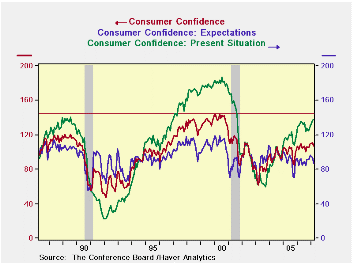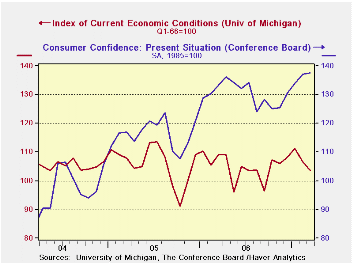
Consumer confidence fell in the current month (March). The drop was fairly sharp to 107.2 from 111.2. But the current conditions index improved to 137.6 from 137.1 while the expectations index crashed and burned dropping to 86.9 from 93.8, hitting its lowest value since August of last year.
The chart on the left sketches out the path of consumer confidence and its two components over the past two business cycles. We add a horizontal line showing that current conditions has not yet hit the peak of the cycle that ended in 1990; they are, of course, way below the peak of the past cycle. Expectations have remained contained to a much lower profile than in either of the previous expansions.
But even a quick perusal of this graph reveals that expectations, important as they are, do not tell of the tipping point around recessions. Indeed we have relatively more FALSE signals from weak expectations than from current conditions – although sometimes from both. We see examples in expansion periods of expectations falling, sometimes quite sharply, but with the expansion continuing. The BEST signal of recession is that broad rounded top and fall off in CURRENT CONDITIONS. Presently that signal is not in play. So we continue to regard the ongoing upswing in consumer confidence as a good thing and brush off this month as mere volatility.
For the moment the signal on current conditions is brighter in the Conference Board report than in the U of M report (see graph on the right).What drives confidence/Sentiment?
We use the table below to help to answer that question and to draw comparisons between the U of M and Conference Board reports.The table presents correlation coefficients between the components on each survey (current conditions and expectations) and relates them to underlying economic variables of interest. You can readily see that the correlations for U of M on current conditions differ from the Conference Board on Current conditions and that current conditions differ from expectations and so on.
Reactions of Various Components to Selected Indicators| Expectations | ||||||||
| Fed Funds | 10-Year | DJIA | OIL | CPI | Unemployment | Activity | Jobs | |
| Conference Board | 0.311 | 0.082 | 0.370 | -0.120 | -0.295 | -0.535 | 0.089 | 0.286 |
| University of Michigan | 0.311 | -0.035 | 0.434 | -0.245 | -0.404 | -0.670 | 0.099 | 0.344 |
| Current Conditions/Present Situation | ||||||||
| Fed Funds | 10-Year | DIJA | OIL | CPI | Unemployment | Activity | Jobs | |
| Conference Board | 0.533 | -0.171 | 0.650 | 0.086 | -0.181 | -0.958 | -0.016 | 0.370 |
| University of Michigan | 0.428 | -0.108 | 0.472 | 0.012 | -0.233 | -0.779 | 0.146 | 0.146 |
| Correlations on contemporaneous readings: activity is Real Retail Sales & IP over 3-mos | ||||||||
| · What is more interesting is that we have ranked the importance of each factor across Confidence components and found that the ranking of the various effects – the ordering of the importance - is much the same for expectations in the Conference Board and the U of M frame works. With rank correlation of 0.93 (1.0 is perfect correlation) for expectations; the rank correlation for current conditions is 0.84, still relatively high.· The correlations in the table above refers to data since the end of the 1991 recession, encompassing nearly 200 observations.· Beyond the rough similarity in the U of M and Conference Board component rankings in their respective reactions to key economic factors we find: For expectations:
normal">For current conditions the rankings are much the same, but for the Conference Board framework the two jobs measures become even more important and so does the DJIA. The current Fed funds becomes the third most important correlation in each current index and also remains positive as its correlation rises from its value in the expectations framework. For both indexes unemployment has the highest correlation, the DJIA is second and Fed funds is third, followed by jobs or the CPI. |
|---|
| Permits/Starts | Starts/New Houses | New Houses/Existing Houses | New Houses (-2)/Existing Houses | |
| Max | 1.167 | 2.054 | 0.201 | 0.198 |
| Min | 0.921 | 1.402 | 0.127 | 0.153 |
| Avg | 1.030 | 1.703 | 0.172 | 0.172 |
| Percentile | 34.1% | 60.8% | 0.0% | 7.0% |
| · Let’s walk you through the values in this table… We conclude that for the present situation business conditions are still expansionary (diffusion at 56.7 >50 (50 is neutral)). The present conditions business situation reading overall is in the 94th percentile of those since Oct 2003 (this refers to the level of the diffusion reading itself, meaning it has been stronger only 6% of the time); it is a relatively high reading. The percentage of respondents seeing conditions as ‘bad’ is in the 1.5 percentile - very low. The percentage of respondents that see things as normal is in the 36 percentile of their range. Current employment responses are the best of the cycle so far (100th percentile). With the most ‘good’ responses and the least ‘bad’ responses. The percentage saying things are normal was in the bottom 8 percent (7.6%) of historic readings. · Expectations are more equivocal. For business conditions, employment and income, ‘bad’ responses out rank ‘good’ responses substantially. BUT, despite that fact, bad responses are generally still in the lower 25% of their respective ranges and ‘Normal’ responses are in the 90-plus percentile. So things are substantially normal with deterioration around the edges. Overall diffusion for the expectations categories is still positive for business conditions and income, but contractionary for jobs (48.1<50) · Buying plans are weak by historic comparison except for appliances.
normal">The Regional Picture: | ||||||||||||||||||||||||||||||||||||||||||||||||||||||||||||
|---|---|---|---|---|---|---|---|---|---|---|---|---|---|---|---|---|---|---|---|---|---|---|---|---|---|---|---|---|---|---|---|---|---|---|---|---|---|---|---|---|---|---|---|---|---|---|---|---|---|---|---|---|---|---|---|---|---|---|---|---|
| Selected housing ratios | Permits/Starts | Starts/New Houses | New Houses/Existing Houses | New Houses (-2)/Existing Houses | Max | 1.167 | 2.054 | 0.201 | 0.198 | Min | 0.921 | 1.402 | 0.127 | 0.153 | Avg | 1.030 | 1.703 | 0.172 | 0.172 | Percentile | 34.1% | 60.8% | 0.0% | 7.0% | |||||||||||||||||||||||||||||||||||
| Selected housing ratios | ||||||||||||||||||||||||||||||||||||||||||||||||||||||||||||
| Permits/Starts | Starts/New Houses | New Houses/Existing Houses | New Houses (-2)/Existing Houses | |||||||||||||||||||||||||||||||||||||||||||||||||||||||||
| Max | 1.167 | 2.054 | 0.201 | 0.198 | ||||||||||||||||||||||||||||||||||||||||||||||||||||||||
| Min | 0.921 | 1.402 | 0.127 | 0.153 | ||||||||||||||||||||||||||||||||||||||||||||||||||||||||
| Avg | 1.030 | 1.703 | 0.172 | 0.172 | ||||||||||||||||||||||||||||||||||||||||||||||||||||||||
| Percentile | 34.1% | 60.8% | 0.0% | 7.0% | ||||||||||||||||||||||||||||||||||||||||||||||||||||||||
| · Regionally there is more evidence of slippage. This month the diffusion reading tells us that there was month-to-month improvement in only 33% of the regions. Year-over-year, only 44% of the regions have stronger confidence today than one year ago. We know that current conditions have done relatively better than expectations. Overall, the present situation is better year-over-year by 2.5% while expectations are lower by 3.8%. · The Consumer Confidence report shows us some irregularities in the economy. Certainly expectations are having a hard time coming to grips with the stock market turbulence, stubborn inflation and higher oil/gas prices. But for the present situation the more powerful draw of low unemployment, ongoing job gains and past stock market gains have underpinned a solid reading. It seems clear that the economy is still fighting off some stress, but also that conditions may be better than what the expectations index is telling us. At this point in the cycle current conditions readings matter more. · When both expectations and current conditions slip together and current conditions form that round shouldered drop – we will worry. | ||||||||||||||||||||||||||||||||||||||||||||||||||||||||||||
| Permits/Starts | Starts/New Houses | New Houses/Existing Houses | New Houses (-2)/Existing Houses | |
| Max | 1.167 | 2.054 | 0.201 | 0.198 |
| Min | 0.921 | 1.402 | 0.127 | 0.153 |
| Avg | 1.030 | 1.703 | 0.172 | 0.172 |
| Percentile | 34.1% | 60.8% | 0.0% | 7.0% |



 Global
Global